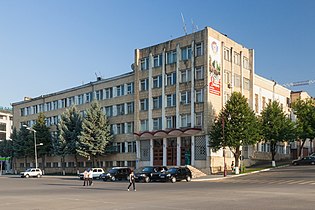| Revision as of 13:18, 3 January 2024 view sourceChessrat (talk | contribs)Extended confirmed users7,592 editsNo edit summary← Previous edit | Revision as of 11:43, 4 January 2024 view source RocketKnightX (talk | contribs)Extended confirmed users1,801 editsm RocketKnightX moved page Stepanakert to Khankendi (city) over redirectTags: Mobile edit Mobile web edit Advanced mobile editNext edit → |
| (No difference) | |
Revision as of 11:43, 4 January 2024
City in Nagorno-Karabakh, Azerbaijan "Xankəndi" redirects here. For other uses, see Xankəndi (disambiguation).
City in Karabakh, Azerbaijan
| Stepanakert / Khankendi
Template:Lang-hy Template:Lang-az | |
|---|---|
| City | |
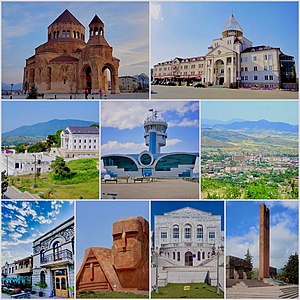 From top left: From top left: Holy Mother of God Cathedral Renaissance Square • Downtown Stepanakert Stepanakert Airport • Stepanakert skyline Park Hotel Artsakh • We Are Our Mountains Garabagh University • Victory Monument | |
  | |
| Coordinates: 39°48′55″N 46°45′7″E / 39.81528°N 46.75194°E / 39.81528; 46.75194 | |
| Country | Azerbaijan |
| Region | Karabakh |
| City status | 1940 |
| Area | |
| • Total | 29.12 km (11.24 sq mi) |
| Elevation | 813 m (2,667 ft) |
| Population | |
| • Total | 0 |
| • Density | 0.0/km (0.0/sq mi) |
| Time zone | UTC+4 (GMT+4) |
| Area code | +994 26 |
| Sources: Stepanakert city area and population | |
Stepanakert (Template:Lang-hy, Eastern pronunciation: Template:IPA-hy) or Khankendi (Template:Lang-az, Template:IPA-az) is a city in Karabakh Economic Region, Azerbaijan. The city is located in a valley on the eastern slopes of the Karabakh mountain range, on the left bank of the Qarqarçay (Karkar) river.
The area that would become Stepanakert was originally an Armenian settlement named Vararakn. During the Soviet period, the city was made the capital of the Nagorno-Karabakh Autonomous Oblast within the Azerbaijan Soviet Socialist Republic, becoming a hub for economic and industrial activity. The city was populated mostly by Armenians, with an Azerbaijani minority also present. It became a hotbed for political activity, serving as the center for Armenian demonstrations calling for the unification of Nagorno-Karabakh with Armenia. Stepanakert suffered extensive damage following the dissolution of the Soviet Union and the outbreak of the First Nagorno-Karabakh War and passed into the hands of local Armenians with the establishment of the Republic of Artsakh in 1994. The city was the capital city of the Republic of Artsakh for the duration of its existence from 1994 to 2023.
In September 2023, Azerbaijani forces took control of Republic of Artsakh, including Stepanakert. Almost the entire population fled to Armenia out of fears for their safety under Azerbaijani rule. The city is currently unpopulated; Azerbaijani president Ilham Aliyev stated that the city would be repopulated in 2024.
Prior to the Azerbaijani takeover, the city was a regional center of education and culture, being home to Artsakh University, musical schools, and a palace of culture. The economy was based on the service industry and had varied enterprises, food processing, wine making, and silk weaving being the most important.
Etymology
Medieval Armenian sources attest to a settlement in the locale called Vararakn (Template:Lang-hy). In 1847, the village was officially renamed from Vararakn to Khankendi by the Russian authorities; however, Vararakn remained the local Armenian name for the town until 1923.
Most Azerbaijani sources claim that the settlement was built in late 18th century, as a place of rest for the heads of the Karabakh Khanate. In the first years, it was known as "Khan's village" (Template:Lang-az) because only the khan's family and his relatives lived there. By the 19th century, the settlement was renamed Khankendi ("village of the khan" in Azerbaijani).
The town was renamed Stepanakert ("city of Stepan") in 1923, after Armenian Bolshevik revolutionary Stepan Shahumian. The name is formed from the words Stepan (Template:Lang-hy) and kert (Template:Lang-hy).
History
Founding

According to medieval Armenian sources, the settlement was originally an Armenian village named Vararakn (Template:Lang-hy). From the 10th–16th centuries, the settlement was a part of the Armenian Principality of Khachen. Over the centuries, it would successively pass into the hands of the meliks of Karabakh and the Karabakh khans before coming under the control of the Russian Empire in 1822.
In the Russian Empire, the town was a part of the Shusha uezd of the Elizavetpol Governorate. According to the 19th-century author Raffi, in 1826, the local Armenian meliks met with the Persian crown prince Abbas Mirza, who had invaded Karabakh with his army, in the village to reconcile with the Persians and ensure the safety of the Karabakh Armenian population. In 1847, Vararakn was a village of about 132 houses, consisting of 80 Armenian households, 52 Russian households, an Armenian church, and a cemetery. That same year, the village was renamed from Vararakn to Khankendi. By 1886, there were 52 houses in the settlement. The population of Khankendi consisted of retired soldiers and their descendants, who belonged to the Russian Orthodox Church. The population was engaged in agriculture, as well as various crafts, carriage, the renting of apartments (mainly to military personnel), and so on. After 1898, the tsarist government turned Khankendi into a Russian military garrison. The garrison consisted of barracks, hospitals, and a church, as well as several houses where officers' families and a small local population, who supplied the military units with food, lived. The local population consisted of Armenians and Azerbaijanis.
Soviet era
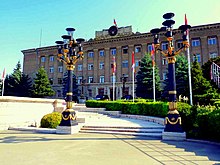
In February 1920, after a body thought to be of an Azerbaijani soldier was found, an anti-Armenian riot took place in the village that claimed several hundred lives. Following the massacre of the Armenian population of Shusha in March 1920, the city received an influx of Armenians; as a result, Armenians formed the majority of the population from that time onwards. In the summer of 1920, the city was occupied by part of the Red Army. In 1923, Khankendi was renamed Stepanakert by the Soviet government in honor of Stepan Shahumian, a fallen Bolshevik party member and leader of the 26 Baku Commissars. The former regional capital was Shusha. However, following the depopulation of Armenians in Shusha, the capital of the Nagorno-Karabakh Autonomous Oblast (NKAO) was sited in Stepanakert. At the time of the formation of the NKAO, Stepanakert was a dilapidated settlement, where the number of surviving buildings barely reached 10 to 15. Some of the buildings were completely destroyed, others lacked doors and windows, while only walls remained from a number of buildings. During the first years of the oblast, some of the buildings were restored and many were rebuilt, roads were improved, and electricity and telephone communications were installed in the city. In time, Stepanakert grew to become the region's most important city (a status it received in 1940). Its population rose from 10,459 in 1939 to 33,000 in 1978.
In 1926, municipal authorities adopted a new city layout designed by Aleksandr Tamanian; two additional designs for expansion were approved in the 1930s and 1960s, both of which retained Tamanian's initial plan. Several schools and two polyclinics were established, and an Armenian drama theater was founded in 1932 and named after Maxim Gorky. In 1960, the ensemble of the central square of Stepanakert was built with the building of the regional committee (now the NKR government). This square, then named after Lenin, became the arena of many rallies demanding the transfer of the NKAO to the Armenian SSR. By 1968, the first outbreak of ethnic violence occurred in Stepanakert. In the city, a trial was held over an Azerbaijani director of the city school who was accused of murdering an Armenian girl. The Armenians, who considered the verdict of the Azerbaijani judge too lenient, gathered outside the court building and burned the car which the criminal and judge were in.
Stepanakert served as Nagorno-Karabakh's main economic hub, and by the mid-1980s there were nineteen factories in operation in the city, including an electrical and asphalt plant. By the end of the Soviet era, Stepanakert had an agricultural technical school, a pedagogical institute, a medical and music school, a local history museum, and a drama theater.
The political and economic reforms that General Secretary Mikhail Gorbachev undertook in 1985 saw a marked decentralization of Soviet authority. Armenians, in both the Armenian SSR and Nagorno-Karabakh, viewed Gorbachev's reform program as an opportunity to unite the two together. On 20 February 1988, tens of thousands of Armenians gathered to demonstrate in Stepanakert's Lenin Square (now Renaissance Square) to demand that the region be joined to Armenia. On the same day, the Supreme Soviet of Nagorno-Karabakh voted to join the Armenian SSR, a move strongly opposed by the Soviet Azerbaijani authorities.
Relations between Stepanakert's Armenians and Azerbaijanis, who supported the Azerbaijani government's position, deteriorated in the following years. Inter-ethnic strife in the city in September 1988, encompassing physical attacks and burning of property, forced nearly all Azerbaijanis to flee the city. The Soviet Army took up positions in the city and announced a curfew three days later. In 1990 the army dispatched special forces units and various other elements to Stepanakert in order to prevent its takeover by Azerbaijani forces.
First Nagorno-Karabakh War and Armenian control
Main article: Stepanakert in the Republic of Artsakh

After Azerbaijan declared its independence from the Soviet Union in 1991, Stepanakert was renamed Khankendi by the Azerbaijani government. Fighting broke out over control of Nagorno-Karabakh, which, after three years of war, resulted in Armenian control of the region and a connecting corridor to Armenia to the west. Prior to the conflict, Stepanakert was the largest city of the NKAO, with a population of 70,000 out of a total 189,000 (Armenians at the time comprised 75% of the region's total population). By early 1992, that figure had dropped to 50,000.
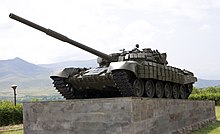
During the war, the city suffered immense damage from Azerbaijani bombardment, especially in early 1992 when the Azerbaijanis positioned BM-21 Grad rocket artillery in Shusha and rained down missiles over Stepanakert. A journalist for Time noted in an April 1992 article that "scarcely a single building escaped damage in Stepanakert." It was not until 9 May 1992, with the capture of Shusha, that the ground bombardment ceased. The city, nevertheless, continued to suffer aerial bombardment until the end of the war. As a result, the majority of the city was in a severely damaged state. As of 2016, the city had not been completely restored from the war.
The city came under intense bombardment once again during the Second Nagorno-Karabakh War in 2020. Residential areas were continuously hit by the Azerbaijani Army with cluster munitions throughout the war, starting on the first day of fighting, and residents were urged to use the city's bomb shelters. As Azerbaijani forces advanced on the city of Shusha, the Lachin corridor was shut down by Artsakh authorities.
With Azerbaijani forces 15 km (9.3 mi) from the capital, a ceasefire agreement was signed on 10 November. As part of the agreement, Russian peacekeepers were deployed to the region. Following the war, the population of Stepanakert swelled to 75,000 residents as a result of some 10,000 to 15,000 displaced people who lost their homes elsewhere in the Republic of Artsakh during the war.
Control by Azerbaijan (2023–present)

On 19–20 September 2023 Azerbaijan launched a new offensive in the region, which ended in a ceasefire and led to a mass exodus of ethnic Armenians a few days later. By 29 September 2023, police of the Ministry of Internal Affairs of Artsakh left all their weapons in Stepanakert and completely abandoned the region. Azerbaijani police vehicles began patrolling the area on 29 September and the Azerbaijani flag was placed on the city's We Are Our Mountains monument. From 1 October, Azerbaijani officials began working from the former Artsakh police headquarters, Azerbaijan took over responsibility for medical services in the city and its area was covered by the Azerbaijani mobile networks. An Al Jazeera news crew reported from the city later that day, showing deserted streets in what the reporter described as "A ghost town with no soul left".
After the offensive and Armenian exodus, in contrast with Ilham Aliyev's claims of respecting the rights of the remaining Armenian population, Azerbaijani officials issued a map of Stepanakert renaming one of the streets after Enver Pasha, one of the main perpetrators of the Armenian genocide. President Ilham Aliyev visited the city on 15 October and officially raised the flag of Azerbaijan at the building that was previously used as the Artsakh Presidential Palace. Azerbaijan held a military parade in the city on 8 November.
The city has been unpopulated since the flight of the entire population to Armenia ahead of the advancing Azerbaijani forces in 2023. Azerbaijani president Ilham Aliyev stated that the city would be repopulated in 2024.
Geography and climate
Stepanakert is located on the Karabakh plateau, at an average altitude of 813 m (2,667 ft) above sea level.
The city has a humid subtropical climate (Cfa) according to the Köppen climate classification system and a semi-arid climate (BS) according to the Trewartha climate classification system. In the month of January, the average temperature drops to 0.5 °C (33 °F). In August, it averages around 22.6 °C (73 °F). Extreme temperatures ranged from −15.0 °C (5 °F) on January 8, 1974 to 37.0 °C (99 °F) on July 11, 1978.
| Climate data for Stepanakert (1961–1990 normals, extremes 1959–1991) | |||||||||||||
|---|---|---|---|---|---|---|---|---|---|---|---|---|---|
| Month | Jan | Feb | Mar | Apr | May | Jun | Jul | Aug | Sep | Oct | Nov | Dec | Year |
| Record high °C (°F) | 16.1 (61.0) |
19.0 (66.2) |
22.8 (73.0) |
30.3 (86.5) |
30.0 (86.0) |
37.0 (98.6) |
37.0 (98.6) |
36.0 (96.8) |
31.0 (87.8) |
25.0 (77.0) |
21.2 (70.2) |
21.0 (69.8) |
37.0 (98.6) |
| Mean daily maximum °C (°F) | 4.7 (40.5) |
5.2 (41.4) |
9.0 (48.2) |
16.1 (61.0) |
19.5 (67.1) |
24.5 (76.1) |
28.1 (82.6) |
27.1 (80.8) |
23.2 (73.8) |
16.4 (61.5) |
11.4 (52.5) |
7.3 (45.1) |
16.0 (60.9) |
| Daily mean °C (°F) | 1.1 (34.0) |
1.4 (34.5) |
5.1 (41.2) |
11.6 (52.9) |
15.3 (59.5) |
19.8 (67.6) |
23.3 (73.9) |
22.3 (72.1) |
18.7 (65.7) |
12.6 (54.7) |
7.7 (45.9) |
3.7 (38.7) |
11.9 (53.4) |
| Mean daily minimum °C (°F) | −2.6 (27.3) |
−2.5 (27.5) |
1.1 (34.0) |
7.0 (44.6) |
11.0 (51.8) |
15.1 (59.2) |
18.4 (65.1) |
17.4 (63.3) |
14.2 (57.6) |
8.7 (47.7) |
4.0 (39.2) |
0.1 (32.2) |
7.7 (45.8) |
| Record low °C (°F) | −15.0 (5.0) |
−11.0 (12.2) |
−12.7 (9.1) |
−1.0 (30.2) |
4.0 (39.2) |
6.6 (43.9) |
11.3 (52.3) |
10.9 (51.6) |
6.0 (42.8) |
−2.0 (28.4) |
−6.0 (21.2) |
−8.6 (16.5) |
−15.0 (5.0) |
| Average precipitation mm (inches) | 19 (0.7) |
25 (1.0) |
42 (1.7) |
49 (1.9) |
102 (4.0) |
79 (3.1) |
41 (1.6) |
27 (1.1) |
34 (1.3) |
39 (1.5) |
35 (1.4) |
13 (0.5) |
505 (19.9) |
| Average precipitation days | 6 | 6 | 10 | 10 | 14 | 10 | 4 | 4 | 6 | 6 | 5 | 4 | 85 |
| Source: NOAA | |||||||||||||
Politics and government
During the period of the USSR, Stepanakert served as the capital of the Nagorno-Karabakh Autonomous Oblast within the Azerbaijani Soviet Socialist Republic, between 1923 and 1991. With the self-declared independence of Artsakh in 1991, Stepanakert continued with its status as the political and cultural centre of the newly established republic, being home to all the national institutions: the Government House, the National Assembly, the Presidential Palace, the Constitutional Court, all ministries, judicial bodies and other government organizations.
Under the Republic of Artsakh, the city of Stepanakert was governed by the Stepanakert City Council and the mayor of Stepanakert. The last local elections took place in September 2019. The most recent mayor was Davit Sargsyan.
Government buildings during Artsakh control
Demographics
| Year | Armenians | Azerbaijanis | Others | Total | |||
|---|---|---|---|---|---|---|---|
| Number | % | Number | % | Number | % | ||
| 1897 | 628 | 42.0 | 442 | 29.6 | 425 | 28.4 | 1,495 |
| 1926 | 2,724 | 85.4 | 343 | 10.8 | 122 | 3.8 | 3,189 |
| 1939 | 9,079 | 86.8 | 672 | 6.4 | 708 | 6.8 | 10,459 |
| 1959 | 17,640 | 89.5 | 1,143 | 5.8 | 920 | 4.7 | 19,703 |
| 1970 | 26,684 | 88.1 | 2,762 | 9.1 | 847 | 2.8 | 30,293 |
| 1979 | 33,898 | 87.0 | 4,303 | 11.0 | 747 | 2.0 | 38,948 |
| September 1988: First Nagorno-Karabakh War: Expulsion of Azerbaijani population | |||||||
| 2005 | 49,848 | 99.7 | 2 | 0.0 | 136 | 0.3 | 49,986 |
| 2010 | 52,900 | 52,900 | |||||
| 2015 | 55,309 | 55,309 | |||||
| September-November 2020:Second Nagorno-Karabakh War | |||||||
| 2021 | 75,000 | 75,000 | |||||
| September 2023: Azerbaijani offensive in Nagorno-Karabakh | |||||||

According to the data of the Transcaucasian Statistical Committee, extracted from the family lists of 1886, there were 71 houses and 279 residents registered in Khankendi (recorded as Ханкенды, Khankendy in Russian), of which 276 were Russians, 2 Armenians and 1 Tatar (later known as Azerbaijani), who were respectively Orthodox, Armenian Gregorian and Sunni Muslim by religion. According to the Russian Empire Census of 1897, the village, labelled as Khan-kendy (Template:Lang-ru), had a population of 1,495 consisting of 801 men and 694 women; there were 628 Armenian Apostolics, 442 Muslims, and 394 Orthodox.
According to the 1910 publication of the Caucasian Calendar—a statistical almanac published by the office of the viceroy—there were 362 residents in the village of Khankendy of the Shusha uezd of the Elizavetpol Governorate in 1908, predominantly Russians. The 1912 publication of the Caucasian Calendar registered 1,076 residents, also predominantly Russians. According to the 1915 publication of the Caucasian Calendar, there were 1,550 predominantly Tatar residents in Khankendi. According to the Azerbaijani agricultural census of 1921, Khankendi had a population of 1,208 residents, mostly Armenians. In 1973, Stepanakert had a population of 32,000.
Religion
The late-19th-century church of Vararakn was destroyed in the 1930s to build the Stepanakert Drama Theatre. Throughout the rest of the Soviet era, there were no traditional churches in Stepanakert, although most of the population of the city were members of the Armenian Apostolic Church.
The church of Surp Hakob (or Saint James) was opened in 2007; it remained the only open church in the city until 2019. The church was financed by Nerses Yepremian from Los Angeles. The church was consecrated on 9 May 2007, in honor of the 15th anniversary of the capture of Shusha by Armenian forces.
The construction of the Holy Mother of God Cathedral was launched on 19 July 2006. The cost of the project was expected to be around US$2 million and the architect of the church is Gagik Yeranosyan. However, the construction process was slow due to a lack of financial resources. The inauguration of the church was expected to take place in September 2016. Construction finished and the church was opened in 2019.
There was small community of Armenian Evangelicals with around 500 members. The only Armenian evangelical church in Artsakh was located in Stepanakert. The Evangelical community supported many schools, hospitals and other institutions through the help of the Armenian Diaspora.
Transport


Bus
Stepanakert was served by a number of regular minibus lines. Old Soviet-era buses have been replaced with new modern buses. Regular trips to other provinces of Nagorno-Karabakh were also operated from the city.
Air
During the period of the Soviet Union, Stepanakert was served by the nearby Stepanakert Airport, north of the city near the village of Ivanyan. In 2009, facilities reconstruction and repair work began with the intent of re-opening the airport. However, the airport never re-entered operation during the period of Stepanakert being under the control of Artsakh, for political reasons.
Railway
Stepanakert used to be connected through a railway line with the Yevlakh station on the Baku-Tbilisi railway. However, trips were discontinued due to the Nagorno-Karabakh conflict.
Economy
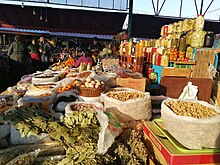
During the Artsakh control, the city was a regional center of education and culture, being home to Artsakh University, musical schools, and a palace of culture. The economy is based on the service industry and has varied enterprises, food processing, wine making, and silk weaving being the most important. Stepanakert was the center of the economy of Artsakh. Prior to the First Nagorno-Karabakh War, the economy of Stepanakert was mainly based on food-processing industries, silk weaving and winemaking. Inhabitants also engaged in producing furniture and footwear. The economy was severely damaged due to the 1988 earthquake in Armenia and the First Nagorno Karabakh war. In the years following, the economy was developed further, mainly due to investments from the Armenian diaspora. However, following the 2020 Nagorno-Karabakh war, the economy once again experienced severe damage, particularly in the tourism sector.
Culture
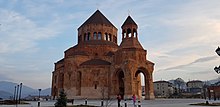
The Vahram Papazyan Drama Theater of Stepanakert was founded in 1932. In 1967, the monumental complex of Stepanakert known as We Are Our Mountains was erected to the north of Stepanakert, It is widely regarded as a symbol of the Armenian heritage of the historic Artsakh. After the independence of Armenia, many cultural and youth centres were reopened. The cultural palace of the city is named after Charles Aznavour.
The Artsakh State Museum based in Stepanakert, has an important collection of ancient artifacts and Christian manuscripts.
Education
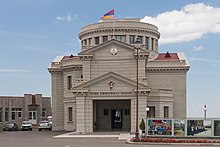
Stepanakert was the center of higher education in Artsakh. It is home to Garabagh University, founded in 1969 as a branch of the Baku Pedagogical Institute. In 1973, it was renamed Stepanakert Pedagogical Institute and following the independence of Nagorno-Karabakh, in 1992, it was renamed Artsakh State University. During the period of Artsakh control, the university offered courses spread across seven departments and has 4,500 students. It received its current name in November 2023 following the takeover by Azerbaijan.
Many new schools in Stepanakert were opened from the late 1990s to 2010 with the help of the Armenian diaspora. Existing schools were also renovated with donations from the diaspora.
Sport

Football is a popular sport in Stepanakert; Khankendi City Stadium has a capacity of 15,000. In December 2023, the first football match since the resumption of Azerbaijani control was played, between MOIK Baku and Qarabağ FK from Aghdam in the Azerbaijan Cup.
Sister cities
During the period of Artsakh control, Stepanakert was twinned with Montebello, United States, and Mairiporã, Brazil.
Notable people
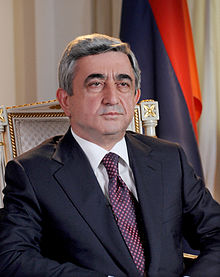
- Armen Abaghian – Armenian academic
- André – Armenian singer
- Don Askarian – Armenian filmmaker
- Vladimir Arzumanyan – Armenian singer, winner of the Junior Eurovision Song Contest 2010
- Samvel Babayan – Armenian military general
- Zori Balayan – Armenian writer
- Karen Karapetyan – 14th Prime Minister of Armenia
- Robert Kocharyan – second President of Armenia
- Fakhraddin Manafov – Azerbaijani actor
- Bakhshi Galandarli – Azerbaijani theatrical figure, actor and director.
- Serzh Sargsyan – third President of Armenia
- Roza Sarkisian – theatre director in Ukraine
- Nikolay Yenikolopyan – Soviet Armenian chemist, academician
- Gor Manvelyan – professional footballer
Notes
- Mentioned as "Muslims" in the 1897 census and "Turks" in the 1926 census.
References
- ^ Hewsen 2001, p. 265
- ^ "President of Azerbaijan: In 2024, residents of Khojaly and Khankendi will return to their homes". report.az. 31 December 2023. Retrieved 2 January 2024.
- "General Characteristics of the NKR" (PDF). Archived (PDF) from the original on 29 September 2015. Retrieved 16 September 2015.
- ^ Baranchikov 2016, p. 225
- ^ Everett-Heath 2019, p. X; Hewsen 2001, p. 265; Adalian 2010, p. 553; Mkrtchyan 1985, pp. 124–125; Mutafian, Chorbajian & Donabédian 1994, p. 139; Kuciukian 2003; Baranchikov 2016, p. 225
- "Nagorno-Karabakh: More than 40,000 refugees flee to Armenia". BBC News. 26 September 2023. Archived from the original on 27 September 2023. Retrieved 29 September 2023.
- "Armenians describe journey to safety after fall of their homeland". The Independent. 29 September 2023. Archived from the original on 30 September 2023. Retrieved 30 September 2023.
- ^ Mkrtchyan 1985, pp. 124–125
- ^ Everett-Heath 2019, p. X; Hewsen 2001, p. 265
- Davies 2017; Payaslian 2008, p. 174; Saparov 2017, p. 539
- ^ Kuliev 1987, p. 49
- Busse 1983, pp. 285–286
- Hagobian & Melkonian 2020, pp. 41–46
- Hakobyan, Melik-Bakhshyan & Barseghyan 1998, p. 773
- Ismail-Zadeh 1976, p. 20
- Kocharyan 1925, p. 46
- Saparov 2012, p. 291
- Libaridian 1988, p. 29
- Adalian 2010, p. 553
- Kocharyan 1925, pp. 67–68
- ^ Prokhorov 1977
- Zubkova 2004, p. 22
- Kaufman 2001, p. 61
- "Карабах: хронология конфликта". 29 August 2005. Archived from the original on 10 August 2011 – via news.bbc.co.uk.
- "Заключение Комитета ВС РСФСР по правам человека". karabakhrecords.info. Archived from the original on 10 October 2019.
- "The collapse of the USSR. Black January in Baku". 15 April 2020. Archived from the original on 15 April 2020. Retrieved 24 April 2020.
- Lobell & Mauceri 2004, p. 58
- ^ Carney, James. "Carnage in Karabakh Archived 30 November 2008 at the Wayback Machine." Time. 13 April 1992. Retrieved 2 August 2007.
- Uhlig 1993, pp. 47–52
- "Karabakh Main City Struck as Armenia Says 'Ready' for Mediation Archived 5 October 2020 at the Wayback Machine." The Moscow Times. 2 October 2020.
- "Azerbaijan: Cluster Munitions Used in Nagorno-Karabakh". Human Rights Watch. 23 October 2020. Archived from the original on 23 October 2020. Retrieved 22 November 2020.
- "Armenia/Azerbaijan: Civilians must be protected from use of banned cluster bombs". www.amnesty.org. 5 October 2020. Archived from the original on 26 January 2021. Retrieved 22 November 2020.
- "Stepanakert prepares for the last stand | Eurasianet". eurasianet.org. Archived from the original on 9 November 2020. Retrieved 12 November 2020.
- "Statement by President of the Republic of Azerbaijan, Prime Minister of the Republic of Armenia and President of the Russian Federation". Kremlin.ru. 10 November 2020. Archived from the original on 11 November 2020. Retrieved 18 December 2021.
- ^ Khachatryan, Karen (13 August 2021). Stepan Kocharyan (ed.). "Drought leads to "unprecedented" water crisis in Stepanakert city". armenpress.am. Stepanakert: Armenpress. Archived from the original on 2 July 2022. Retrieved 18 December 2021.
- "So-called "police" of separatists, abandons weapons in Khankendi, leaves Karabakh". Trend News Agency. 29 September 2023. Archived from the original on 30 September 2023. Retrieved 29 September 2023.
- "Presidential consultant in Karabakh shares picture from Azerbaijan's Khankendi". Businesselend.com. 29 September 2023. Archived from the original on 30 September 2023. Retrieved 29 September 2023.
- "Azerbaijani police takes up serving in Khankendi". News.az. 29 September 2023. Archived from the original on 30 September 2023. Retrieved 1 October 2023.
- "Armenians describe journey to safety after fall of their homeland". The Independent. 29 September 2023. Archived from the original on 30 September 2023. Retrieved 30 September 2023.
- "Azerbaijani authorities provide social, migration services for Karabakh Armenians". Trend News Agency. 1 October 2023. Archived from the original on 2 October 2023. Retrieved 1 October 2023.
- "Azerbaijan takes measures to arrange medical services in Khankendi". News.az. 1 October 2023. Archived from the original on 6 October 2023. Retrieved 1 October 2023.
- "Azercell extends its coverage to Khankendi!". News.az. 1 October 2023. Archived from the original on 5 October 2023. Retrieved 1 October 2023.
- "Nar network in Khankandi city!". Report.az. 1 October 2023. Archived from the original on 5 October 2023. Retrieved 1 October 2023.
- "UN team in Nagorno-Karabakh, a first in 30 years, as ethnic Armenians flee". Aljazeera.com. 1 October 2023. Archived from the original on 2 October 2023. Retrieved 2 October 2023.
- Vincent, Faustine (4 October 2023). "Azerbaijan reissues Nagorno-Karabakh map with street named after Turkish leader of 1915 Armenian genocide". Le Monde.fr. Archived from the original on 4 October 2023. Retrieved 5 October 2023.
- Zaman, Amberin (3 October 2023). "Azerbaijan eyes Iran, Armenia borderlands after 'voluntary' exodus from Nagorno-Karabakh - Al-Monitor: Independent, trusted coverage of the Middle East". www.al-monitor.com. Archived from the original on 5 October 2023. Retrieved 5 October 2023.
- "Azerbaijan's president raises national flag in Nagorno-Karabakh capital". 15 October 2023. Archived from the original on 16 October 2023. Retrieved 16 October 2023.
- "Azerbaijan's president addresses a military parade in Karabakh and says 'we showed the whole world'". AP. 8 November 2023. Retrieved 2 January 2024.
- "Armenians describe journey to safety after fall of their homeland". The Independent. 29 September 2023. Archived from the original on 30 September 2023. Retrieved 30 September 2023.
- King & Nevins 2020, p. 7
- Peel, M. C.; Finlayson, B. L.; McMahon, T. A (2016). "World Köppen Classification". University of Melbourne. Archived from the original on 10 January 2022. Retrieved 22 December 2021.
- "Trewartha climate classification world map". University of Arizona. 2017. Archived from the original on 13 December 2021. Retrieved 22 December 2021.
- ^ "Xankandi (Stepanakert) Climate Normals 1961–1990". National Oceanic and Atmospheric Administration. Archived from the original on 13 May 2023. Retrieved 22 March 2015.
- ^ "Global Surface Summary of the Day – GSOD". National Oceanic and Atmospheric Administration. Archived from the original on 13 May 2023. Retrieved 13 May 2023.
- Sanamyan, Emil (9 September 2019). "Artsakh Elects Mayors and Municipal Councils". USC Institute of Armenian Studies. Archived from the original on 17 June 2023. Retrieved 17 June 2023.
- "Ստեփանակերտի քաղաքապետարան – Քաղաքապետ". www.stepanakert.am (in Armenian). 17 June 2023. Archived from the original on 14 April 2023.
- ^ "население нагорно-карабахской республики". www.ethno-kavkaz.narod.ru. Archived from the original on 16 September 2011.
- ^ Troinitsky, N. A. (1905). Населенные места Российской империи в 500 и более жителей с указанием всего наличного в них населения и числа жителей преобладающих вероисповеданий, по данным первой всеобщей переписи населения 1897 г. [Populated areas of the Russian Empire with 500 or more inhabitants, indicating the total population in them and the number of inhabitants of the predominant religions, according to the first general population census of 1897] (in Russian). Saint Petersburg: Tipografiya Obshchestvennaya polza. p. 32. Archived from the original on 10 August 2022.
- de Waal 2013, p. 46
- De facto and De Jure Population by Administrative Territorial Distribution and Sex Archived 2 March 2011 at the Wayback Machine Census in NKR, 2005. The National Statistical Service of Nagorno-karabakh Republic
- Archived 29 September 2015 at the Wayback Machine Statistics in NKR, 2010. The National Statistical Service of Nagorno-Karabakh Republic
- "Table 1.6 NKR urban and rural settlements grouping according to de jure population number" (PDF). stat-nkr.am. Population Census 2015. Archived from the original (PDF) on 7 March 2020.
- Свод статистических данных о населении Закавказского края, извлечённых из посемейных списков 1886 г. Тифлис. 1893. Archived from the original on 28 April 2021. Retrieved 28 April 2021.
{{cite book}}: CS1 maint: location missing publisher (link) - Кавказский календарь на 1910 год [Caucasian calendar for 1910] (in Russian) (65th ed.). Tiflis: Tipografiya kantselyarii Ye.I.V. na Kavkaze, kazenny dom. 1910. p. 393. Archived from the original on 15 March 2022.
- Кавказский календарь на 1912 год [Caucasian calendar for 1912] (in Russian) (67th ed.). Tiflis: Tipografiya kantselyarii Ye.I.V. na Kavkaze, kazenny dom. 1912. p. 215. Archived from the original on 11 December 2021.
- Кавказский календарь на 1915 год [Caucasian calendar for 1915] (in Russian) (70th ed.). Tiflis: Tipografiya kantselyarii Ye.I.V. na Kavkaze, kazenny dom. 1915. p. 195. Archived from the original on 4 November 2021.
- Азербайджанская сельскохозяйственная перепись 1921 года. Итоги. Т. I. Вып. VIII. Шушинский уезд. Baku: Izdanie Az. Ts.S.U, 1922, pp. 12—13, 21.
- Great Soviet Encyclopedia. Vol. 17. New York: Macmillan. 1973. p. 301.
- Kiesling & Kojian 2005, p. Stepanakert
- Grigorian, Laura (10 May 2007). "ST JAMES CHURCH WAS OPENED IN STEPANAKERT". Armenian News. Archived from the original on 4 April 2012.
- "The church of Stepanakert". www.stepanakert-church.org. Archived from the original on 7 October 2018. Retrieved 18 November 2015.
- "The construction of Stepanakert Cathedral is at its final stages". Archived from the original on 19 November 2015.
- "Official ceremony of consecration and opening Cathedral of Intercession takes place in Stepanakert". news.am. Archived from the original on 8 April 2019. Retrieved 16 May 2019.
- Ghanalanyan, Tigran (9 June 2012). "Activity of the Armenian Evangelicals in Artsakh". noravank.am. Center for the Armenian Studies, “Noravank” Foundation. Archived from the original on 18 December 2021. Retrieved 18 December 2021.
- Holding 2006, p. 208
- "Karabakh To Reopen Stepanakert Airport". Asbarez. 5 October 2010. Archived from the original on 17 January 2013. Retrieved 11 October 2010.
- Statement of the OSCE Minsk Group Co-Chairs Archived 22 January 2013 at the Wayback Machine.
- "Karabakh's airport still waiting for takeoff | Eurasianet".
- New York 1988, p. 80
- Holding & Allen 2019, p. 341
- Lagasse 2000
- Nahapetyan, Haykaram (10 July 2021). "Artsakh's Economy: The Post-war Syndrome and Recovery Efforts". The Armenian Mirror-Spectator. Watertown: Baikar Association. Archived from the original on 22 December 2021. Retrieved 22 December 2021.
- Holding 2006, p. 210
- Chorbajian 2001, p. 140
- "Artsakh president attends Aznavour commemoration event in Stepanakert". Tert.am. 6 October 2018. Archived from the original on 20 December 2021. Retrieved 20 December 2021.
- "MUSEUMS – Karabakh Travel". artsakh.travel. Tourism department of ministry of economy of NKR. Archived from the original on 6 April 2018. Retrieved 6 April 2018.
- (in Armenian) Anon. "ԱՐՑԱԽԻ ՊԵՏԱԿԱՆ ՀԱՄԱԼՍԱՐԱՆ (Arts'akhi Petakan Hamalsaran, Artsakh State University) Archived 27 September 2011 at the Wayback Machine." Azat Artsakh. 29 August 2006. Retrieved 4 September 2009.
- "Garabagh university paving way for bright future of region". Azernews. 2 December 2023. Retrieved 2 January 2024.
- "Armenia Fund Opens 600-Student School in Stepanakert Archived 23 July 2011 at the Wayback Machine." Asbarez. 14 September 2010. Retrieved 4 December 2010.
- "No. 9 School, Stepanakert". armeniafund.org. Armenia Fund. Archived from the original on 21 December 2021. Retrieved 21 December 2021.
- "Xankəndidə "Qarabağ" qazandı". qafqazinfo.az. 21 December 2023. Retrieved 2 January 2024.
- Turksoy, Timucin (21 December 2023). "Karabakh Region Hosts First Football Match Post-Armenian Occupation". Caspian News. Retrieved 2 January 2024.
- Wright, Pam. "Montebello's newest Sister City program has come under fire from an ambassador for the Republic of Azerbaijan." Whittier Daily News. 19 November 2005. Retrieved 2 August 2007.
- LLC, Helix Consulting (February 2019). "Leis aprovadas em SP levam Itamaraty a alertar cidades sobre mal-estar com o Azerbaijão". www.g1.com.br. Archived from the original on 1 January 2020. Retrieved 1 January 2020.
- "Armen Abagyan tragically died". IranAtom.Ru (in Russian). Archived from the original on 23 May 2009. Retrieved 19 December 2021.
- "Անդրեյ Հովնանյան" [André Hovnanyan]. avproduction.am (in Armenian). Armenia: "AV Production" center. Archived from the original on 20 December 2021. Retrieved 19 December 2021.
- "Noted Artsakh filmmaker Don Askarian dies at 69". The Armenian Mirror-Spectator. 11 October 2018. Archived from the original on 1 May 2019. Retrieved 1 May 2019.
- "Minsk 2010/Participants: Vladimir Arzumanyan". junioreurovision.tv. Archived from the original on 8 April 2022. Retrieved 19 December 2021.
- "SAMVEL A. BABAYAN". nankr.am. Official website of the National Assembly of the Republic of Artsakh (Nagorno-Karabakh). Archived from the original on 20 December 2021. Retrieved 19 December 2021.
- "Balayan's page at the Armenian Writer's Union official site". Archived from the original on 24 January 2010.
- "Former Armenian PM Karen Karapetyan Urges Pashinyan to Resign". Hetq Online. 15 December 2020. Archived from the original on 20 December 2021. Retrieved 19 December 2021.
- "ՀՀ 2-րդ նախագահ Ռոբերտ Քոչարյանի կենսագրությունը" [RA 2nd president Robert Kocharyan's biography]. iravaban.net. 28 July 2018. Archived from the original on 2 February 2021. Retrieved 28 January 2021.
- "Mosfilm Fəxrəddin Manafovu killer roluna çəkir Azərbaycanda isə o bu yaxınlarda İbrahim xan obrazını yaradıb". Daily Azerbaijan. National Library of Azerbaijan. 21 April 2007. p. 14. Archived from the original on 27 November 2021. Retrieved 19 December 2021.
- İlham Rəhimli, Rəhimli (2005). Azərbaycan teatr tarixi (PDF). Baku: Çaşıoğlu. p. 864. Archived (PDF) from the original on 29 November 2021. Retrieved 26 April 2023.
- "Official biography of Serzh Sargsyan". President.am. Archived from the original on 3 May 2018. Retrieved 19 December 2021.
- ""У мистецтві я шукаю іншодумців"" [In art I look for dissidents]. m.day.kyiv.ua. 19 February 2021. Archived from the original on 20 December 2021. Retrieved 19 December 2021.
- "Enikolopov, Nikolay Sergeevich". dic.academic.ru. Big biographical encyclopedia. 2009. p. 13. Archived from the original on 20 December 2021. Retrieved 19 December 2021.
Bibliography
- Adalian, Rouben Paul (2010). Historical Dictionary of Armenia (2 ed.). Lanham, Toronto, Plymouth: Rowman & Littlefield. p. 553. ISBN 9780810874503.
- Baranchikov, E.V. (2016). "STEPANAKERT". In Yuri Osipov (ed.). Great Russian Encyclopedia (in Russian). Vol. 31. Moscow. p. 225. ISBN 978-5-85270-367-5. Archived from the original on 30 June 2023. Retrieved 30 June 2023.
{{cite encyclopedia}}: CS1 maint: location missing publisher (link) - Busse, H. (1983). "ABU'L-FATḤ KHAN JAVĀNŠĪR". In Ehsan Yarshater (ed.). Encyclopædia Iranica. Vol. I (3 ed.). New York. pp. 285–286. ISBN 978-0710090928. Archived from the original on 15 December 2021. Retrieved 15 December 2021.
{{cite encyclopedia}}: CS1 maint: location missing publisher (link) - Chorbajian, Levon (2001). The Making of Nagorno-Karabagh: From Secession to Republic. New York: Palgrave Macmillan. p. 140. ISBN 9780230508965.
- Davies, Norman (2017). Beneath Another Sky: A Global Journey Into History. United Kingdom: Penguin Books Limited. ISBN 9781846148323.
- de Waal, Thomas (2013). Black Garden: Armenia and Azerbaijan Through Peace and War. NYU Press. ISBN 9780814785782.
- Everett-Heath, John (2019). The Concise Dictionary of World Place Names (5 ed.). United Kingdom: Oxford University Press. ISBN 9780192556462. Archived from the original on 14 December 2021. Retrieved 14 December 2021.
- Hagobian, Hagob Melik; Melkonian, Ara Stepan (2020). The Five Melikdoms of Karabagh. Yerevan: Gomidas Institute. ISBN 9781909382602. Archived from the original on 23 September 2015. Retrieved 15 December 2021.
- Hakobyan, Tadevos Kh.; Melik-Bakhshyan, Stepan T.; Barseghyan, Hovhannes Kh. (1998). Հայաստանի և հարակից շրջանների տեղանունների բառարան [Dictionary of Toponyms of Armenia and Adjacent Territories] (in Armenian). Vol. 4. Yerevan State University Press. p. 773. OCLC 247335945. Archived from the original on 27 November 2021. Retrieved 16 December 2021.
- Hewsen, Robert H. (2001). Armenia: A Historical Atlas. Chicago: University of Chicago Press. p. 265. ISBN 0-226-33228-4.
- Holding, Deidre; Allen, Tom (2019). Armenia: With Nagorno Karabagh (5 ed.). United Kingdom: Bradt. ISBN 9781784770792.
- Holding, Nicholas (2006). Armenia with Nagorno Karabagh (2 ed.). London: Bradt. ISBN 1-84162-163-3.
- Ismail-Zadeh, D. (1976). "Русские поселения в Закавказье в 30-х — 80-х годах XIX века" [Russian settlements in Transcaucasia in the 30s–80s of the 19th century]. Voprosy Istorii (in Russian). Moscow: Russian Academy of Sciences: 20. ISSN 0042-8779. Archived from the original on 15 December 2021. Retrieved 15 December 2021.
- Kaufman, Stuart (2001). Modern Hatreds: The Symbolic Politics of Ethnic War. New York: Cornell Studies in Security Affairs. p. 61. ISBN 0-8014-8736-6.
- Kiesling, Brady; Kojian, Raffi (2005). "Stepanakert". Rediscovering Armenia : an archaeological/touristic gazetteer and map set for the historical monuments of Armenia (2 ed.). Yerevan: Matit. ISBN 9994101218. Archived from the original on 17 December 2021. Retrieved 17 December 2021.
- King, David C.; Nevins, Debbie (2020). Azerbaijan. New York: Cavendish Square. p. 7. ISBN 9781502658715.
- Kocharyan, G. A. (1925). Nagorno-Karabakh. Baku: Society for Survey and Study of Azerbaijan. p. 46.
- Kuciukian, Pietro (2003). "Capitolo ottavo : La città di Stefano". Giardino di tenebra : viaggio in Nagorno Karabagh [Garden of Darkness: Journey to Nagorno Karabakh]. Milan: Guerini e Associati. pp. 1000–1005. doi:10.1400/41657. ISBN 9788881952854. Archived from the original on 6 July 2022. Retrieved 14 December 2021.
- Kuliev, Jemil (1987). "Khankendi". Azerbaijani Soviet Encyclopedia (in Azerbaijani). Vol. 10. Baku: Azerbaijan National Academy of Sciences.
- Lagasse, Paul (2000). "Khankendi". The Columbia Electronic Encyclopedia. Vol. 1 (6 ed.). New York: Columbia University Press. OCLC 746941797. Archived from the original on 18 December 2021. Retrieved 18 December 2021.
- Libaridian, Gerard J., ed. (1988). The Karabagh File (PDF) (1st ed.). Cambridge, Toronto: Zoryan Institute. ISBN 0-916431-26-6. Archived (PDF) from the original on 20 February 2022.
- Lobell, Steven E.; Mauceri, Phillip (2004). Ethnic Conflict and International Politics: Explaining Diffusion and Escalation. New York: Palgrave MacMillan. p. 58. ISBN 1-4039-6356-8.
- Mkrtchyan, Shahen (1985). "Stepanakert". In Viktor Ambartsumian (ed.). Armenian Soviet Encyclopedia (in Armenian). Vol. 11. Yerevan: Academy of Sciences of the Armenian SSR. pp. 124–125. OCLC 22420067.
- Mutafian, Claude; Chorbajian, Levon; Donabédian, Patrick (1994). "Karabagh In The Twentieth Century". The Caucasian Knot: The History & Geopolitics of Nagorno-Karabagh. London and New Jersey: Zed Books. p. 139. ISBN 9781856492881.
- New York, American Geographical Society of (1988). Soviet Geography. Vol. 29. United States: Scripta Publishing Company. p. 80. Archived from the original on 23 September 2023. Retrieved 23 January 2022.
- Payaslian, Simon (2008). The History of Armenia: From the Origins to the Present. New York: Palgrave Macmillan. p. 174. ISBN 978-0-230-60858-0.
- Prokhorov, Alexander (1977). "Stepanakert". Great Soviet Encyclopedia (3 ed.). Moscow: Sovetskaya Entsiklopediya. OCLC 14476314. Archived from the original on 18 December 2021. Retrieved 18 December 2021.
- Saparov, Arsène (2017). "Contested spaces: the use of place-names and symbolic landscape in the politics of identity and legitimacy in Azerbaijan". Central Asian Survey. 36 (4): 534–554. doi:10.1080/02634937.2017.1350139. S2CID 149221754.
- Saparov, Arséne (2012). "Why Autonomy? The Making of Nagorno-Karabakh Autonomous Region 1918–1925" (PDF). Europe-Asia Studies. 64 (2). Routledge: 281–323. doi:10.1080/09668136.2011.642583. S2CID 154783461. Archived (PDF) from the original on 24 December 2021. Retrieved 24 December 2021.
- Uhlig, Mark A. (1993). "The Karabakh war". World Policy Journal. 10 (4). New York: Duke University Press: 47–52. ISSN 0740-2775. JSTOR 40209334.
- Vardanian, Manuk (2009). Атлас Нагорно-Карабахской Республики [Atlas Nagorno-Karabakh Republic] (in Russian). Yerevan: GNO "Center for Geodesy and Cartography”. p. 45. ISBN 9789994103362.
- Zubkova, Elena Yurievna (2004). "Власть и развитие этноконфликтной ситуации в СССР. 1953-1985 гг" [Power and Development of the Ethno-Conflict Situation in the USSR]. Russian History (in Russian) (4). Moscow: Nauka: 22. ISSN 0869-5687. Archived from the original on 18 December 2021. Retrieved 18 December 2021.
External links
- Stepanakert Municipality (hy)
- 360 Panoramic view of the City Center (en)
- Artsakh tourism Office (en) Archived 24 October 2020 at the Wayback Machine
- Stepanakert on Lonely Planet (en)
- Stepanakert at GEOnet Names Server
| Links to related articles | |||||||||||||||||||||||||||||||||||||||||||||||||||||||||||||||||||||||||||||||||||||||
|---|---|---|---|---|---|---|---|---|---|---|---|---|---|---|---|---|---|---|---|---|---|---|---|---|---|---|---|---|---|---|---|---|---|---|---|---|---|---|---|---|---|---|---|---|---|---|---|---|---|---|---|---|---|---|---|---|---|---|---|---|---|---|---|---|---|---|---|---|---|---|---|---|---|---|---|---|---|---|---|---|---|---|---|---|---|---|---|
| |||||||||||||||||||||||||||||||||||||||||||||||||||||||||||||||||||||||||||||||||||||||
| Administrative divisions of Artsakh | ||
|---|---|---|
| Capital city | ||
| Provinces | ||
| Provincial capitals | ||
| Other urban communities |
| |


